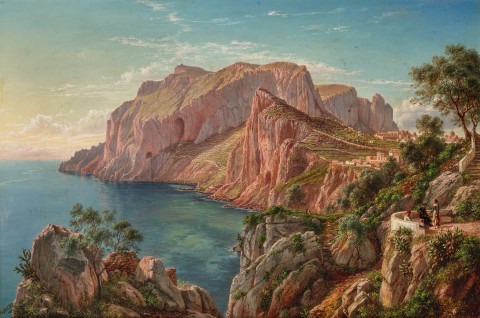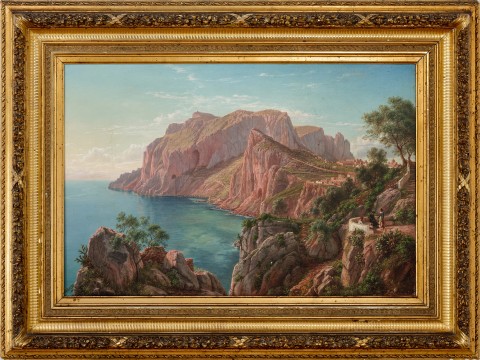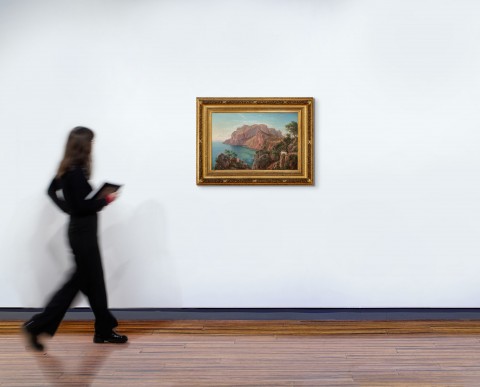VIEW OF CAPRI NEAR NAPLES, 1883
EUGENE VON GUÉRARD
oil on canvas
48.0 x 72.0 cm
signed lower right: E. v. Guérard
inscribed on stretcher bar verso: View of Capri taken from the Punta di Tragara
Fletcher’s Art Gallery, Melbourne
Thomas Shaw, Wooriwyrite, Victoria, acquired from the above in 1884
Thence by descent
Private collection
Sotheby's, Melbourne, 17 April 1989, lot 382
Henry and Dinah Krongold, Melbourne
The Estate of Paul Krongold, Melbourne
Victoria Jubilee Exhibition, Royal Exhibition Building, Melbourne, November 1884 – January 1885, cat. 185, lent by Thomas Shaw
Eugen von Guérard, Art Gallery of New South Wales, Sydney, 7 June – 13 July 1980 and touring; Queensland Art Gallery, Brisbane, August 1980; Ballarat Fine Art Gallery, Victoria, September - October 1980; Art Gallery of South Australia, Adelaide, November 1980 and National Gallery of Victoria, Melbourne, December 1980 - January 1981
Letter von Guerard to James Smith, 28 May 1883, James Smith Papers, Mitchell Library, State Library of New South Wales, Sydney
Letter von Guerard to James Smith, 24 May 1884, James Smith Papers, Mitchell Library, State Library of New South Wales, Sydney
Bruce, C., Eugen von Guérard, Australian National Gallery & Director's Council, Canberra, 1980, p. 118 (illus.)
Bruce, C., Comstock, E., and McDonald, F., Eugene von Guérard: A German Romantic in the Antipodes, Alister Taylor, Sydney, 1982, pl. 47, p. 162
Capri 12 März 82, pen and ink over pencil, Sketchbook XXXX, 1882, 1891, in the collection of State Library of New South Wales, Sydney, DGB16 v. 17: 10
Sketchbook VI, 1835 & 1836, Capri, in the collection of State Library of New South Wales, Sydney DGB14, vol. 8.
Capri, pencil, 1 May 1838
Capri, pencil, 2 May 1838
Abendlandschaft von der Insel Capri, 1846, oil on canvas, 75.0 x 103.5 cm, private collection
View from the ruins of the Villa di Tiberio looking across to Punto di Campanella and Monte Solaro / View from the western part of the island of Capri from the temple of Tiberius, 1885, oil on canvas
Capri: A view of Marina Piccola with Point Faraglione in the distance, 1884/1885, oil on canvas
Eugene von Guérard, one of Australia's greatest landscape painters, was captivated by the light and rugged beauty of the fabled island of Capri. He longed to share the magic of the place he had known so well in his youth with his wife Louise and their daughter Victoria and, on 26 February 1882, the von Guérard family sailed into the Bay of Naples in the ‘most magnificent sunshine’ and on a sea ‘as flat as spilt oil.’1 They stayed at the ‘new Hotel du Vesuve’ (the now legendary Grand Hotel Vesuvio) which, ‘although dearer is in a very beautiful position at Castel del Ovo.’2 It was not far from the Strada Piliero where von Guérard and his artist-father Bernard had lived in the mid-1830s. Von Guérard, Louise and Victoria spent almost a month in Naples visiting the ‘sights of the city and surroundings most worth seeing’ – including the mesmerisingly beautiful island of Capri, a place steeped in history and richly interwoven with literary and artistic associations.3 On 12 March 1882, as they explored the island, von Guérard sketched the view from close to the vantage point of the present work (Fig. 1). View of Capri near Naples, 1883 was painted the following year in his studio in Düsseldorf.
230234 SKETCHBOOK PAGE cmyk.jpg
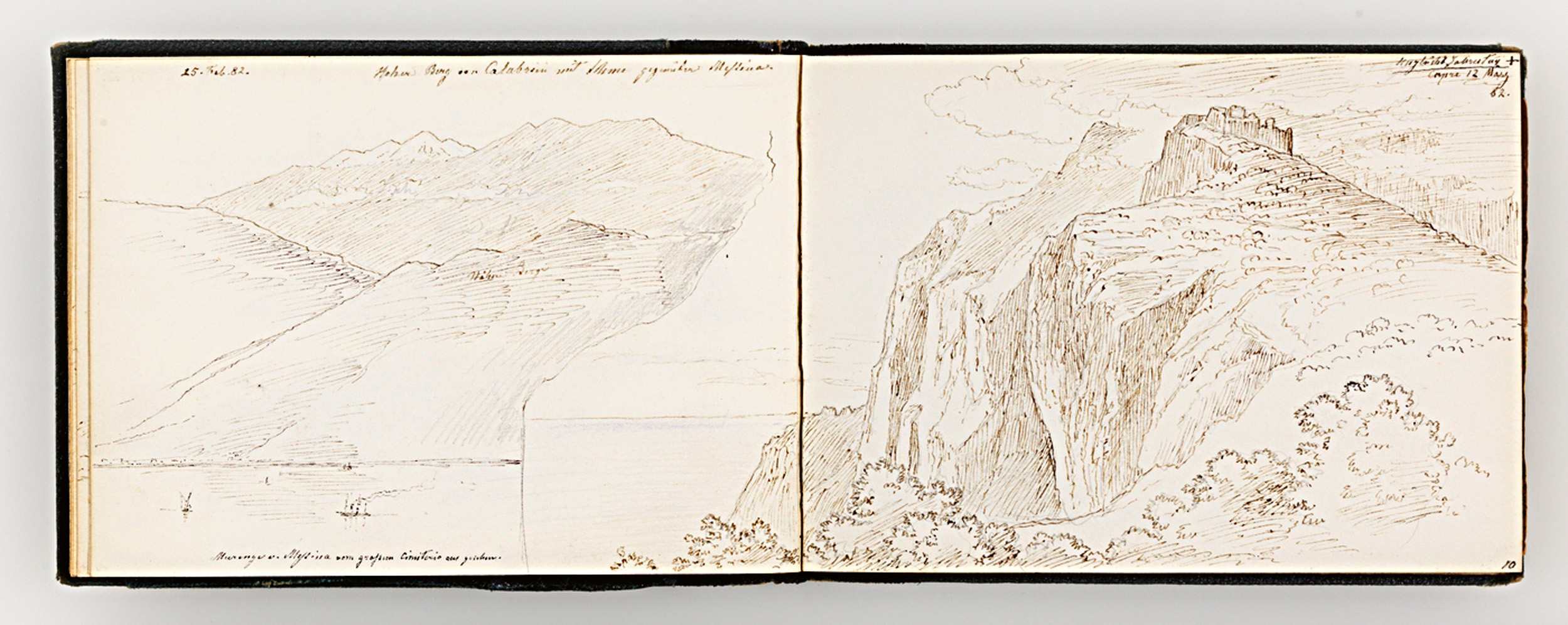
Von Guérard had first visited the island with his father in the summer of 1835. The ever-growing stream of northern painters and writers drawn to the island in the early nineteenth century included von Guérard's associate, the influential Arnhem-born School of Posillipo painter, Anton Sminck Pitloo. The young artist would also have been well aware of August Kopisch's famed discovery of the Blue Grotto in 1826, and of the visits made by German and Scandinavian artists such as Ernst Fries, Leo von Klenze, Johann Christian Dahl, Franz Catel and Carl Morgenstern – all of whom were captivated by the light, intense colour and natural beauty of Capri. In May 1838, just before he left Naples for Düsseldorf to study at its famous Academy, von Guérard made a farewell visit to Capri. The luminous Abendlandschaft von der Insel Capri (Evening Landscape on the island of Capri) of 1846 (Fig 2.) – a work that attracted strong interest when it was presented by Deutscher and Hackett on 15 July 2020 – was based on two finely detailed, light and spacious drawings that date from the 1838 visit.
View of Capri near Naples portrays the same stretch of coastline as that in the 1846 painting – the view looking towards Monte Solaro and Anacapri from Capri. For the present composition, however, von Guérard positioned himself closer to the coast and further around and along the Marina Piccola. From this vantage point, on the Punta di Tragara, he could look directly across the water to the dramatic cliff formations that are the subject of the painting. Here the abstract forms of the island's complex topography and the irregular surfaces of the spectacularly eroded dolomite and limestone cliffs are emphasised by the contrasts between light and the shadow cast by the low rays of the setting sun. Von Guérard's lifetime fascination with – and knowledge of – geology is evident in his depiction of the worn limestone with its surface layers of volcanic ash and tufa, the exposed outcrops of rock along the ridgelines and the caverns eroded by rain and the action of the sea.
230234 cmyk.jpg
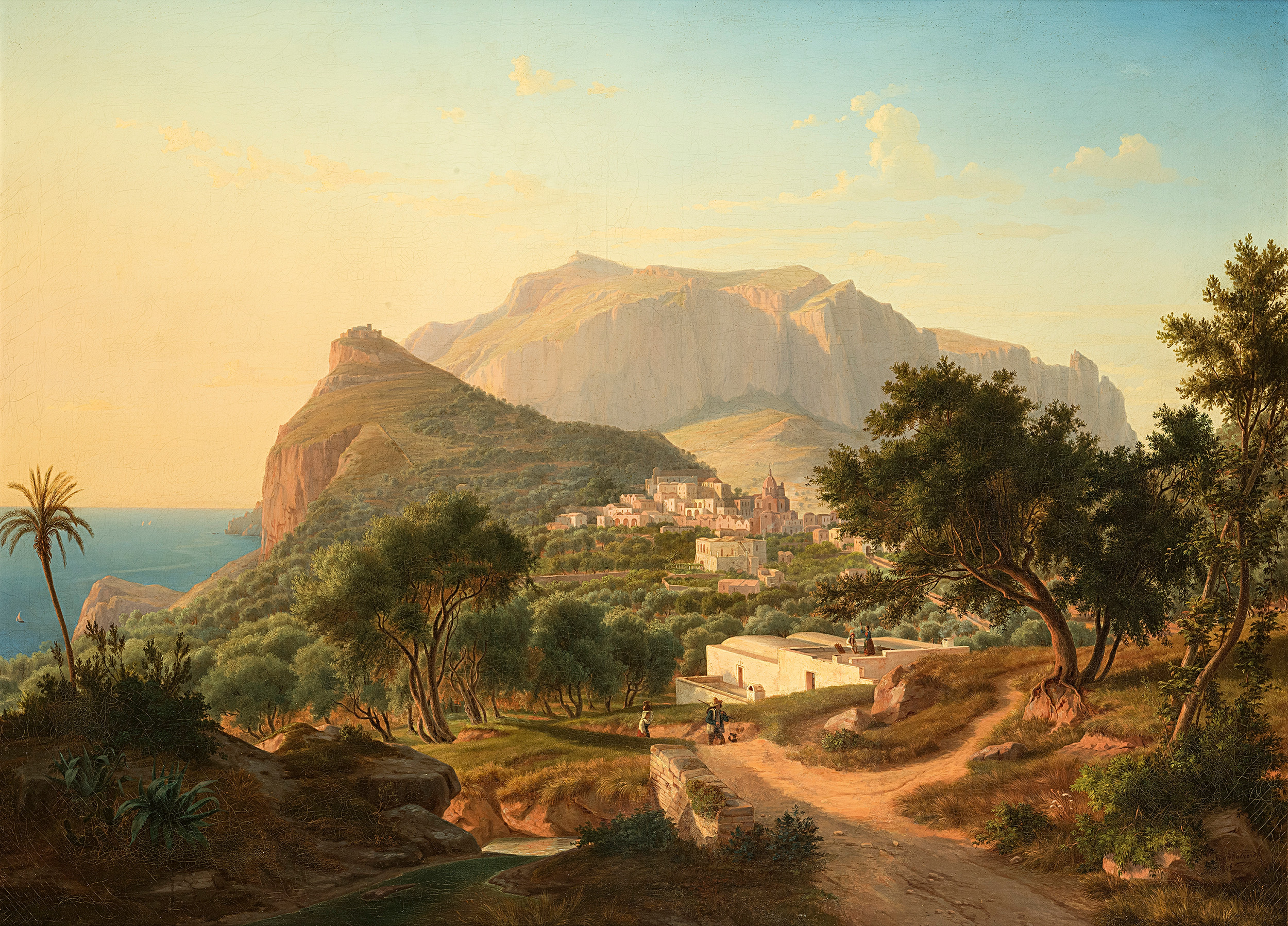
This stretch of the Capri coastline was already one of the most famous views on the island: here we share the experience of being there with a small party of tourists relaxing on the belvedere in the foreground on the right. Further along, the fourteenth century Carthusian Monastery, Certosa, sits at the top of a steep coastal cliff, and beyond it, famous landmarks of the township of Capri can be identified, notably the domed seventeenth-century church of San Stefano. Von Guérard knew the architecture and layout of the township of Capri well, having recorded it with minute precision in 1838: we are invited to take a virtual stroll into the town, or to share the awe of the tiny figures on the grassy ledge below the monastery as they take in the magnitude of the soaring rock walls bathed in the pink, almost crepuscular, light of a sunset slipping into evening. These minute and lively observations are integrated into a work of uplifting breadth, one based on strong compositional geometry and unified by light.
View of Capri near Naples was one of nine works that, in 1884, von Guérard sent to Melbourne to be sold by the successful Collins Street art dealer Alexander Fletcher. It quickly found a buyer in Thomas Shaw, whose Western District pastoral property, 'Wooriwyrite' near Camperdown, von Guérard had first visited and sketched in 1857. View of Capri near Naples was shown at the 1884 Victorian Jubilee Exhibition, on loan from Shaw.
Von Guérard remained captivated by the subject of Capri: he painted Capri: A view of Marina Piccola with Point Faraglione in the distance in late in 1884 or early 1885, and the beautiful, light-infused View from the ruins of the Villa di Tiberio looking across to Punto di Campanella and Monte Solaro in 1885.
1. Von Guérard to Julius von Haast 14 April 1884. Haast Family Papers, Alexander Turnbull Library, Wellington, New Zealand, in Darragh, T., & Pullin, R., Lieber Freund! Letters from Eugen von Guérard to Julius von Haast, Art Gallery of Ballarat, Ballarat, 2018, p. 56.
2. ibid.
3. ibid.
DR RUTH PULLIN
